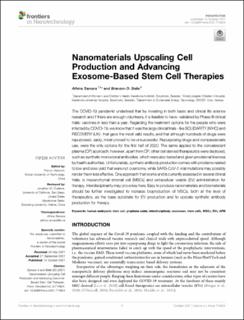| dc.contributor.author | Samara, Athina | |
| dc.contributor.author | Belle, Branson | |
| dc.date.accessioned | 2022-03-02T07:58:07Z | |
| dc.date.available | 2022-03-02T07:58:07Z | |
| dc.date.created | 2021-10-14T09:47:55Z | |
| dc.date.issued | 2021 | |
| dc.identifier.citation | Frontiers in Nanotechnology. 2021, 3 . | en_US |
| dc.identifier.issn | 2673-3013 | |
| dc.identifier.uri | https://hdl.handle.net/11250/2982271 | |
| dc.description.abstract | The COVID-19 pandemic underlined that by investing in both basic and clinical life science research and if there are enough volunteers, it is feasible to have -validated by Phase III clinical trials- vaccines in less than a year. Regarding the treatment options for the people who were infected by COVID-19, we know that it was the large clinical trials - like SOLIDARITY (WHO) and RECOVERY (UK)- that gave the most valid results, and that although hundreds of drugs were repurposed, sadly, most proved to be unsuccessful. Repurposing drugs and compassionate use, were the only options for the first half of 2020. The same applied to the convalescent plasma (CP) approach; however, apart from CP, other cell derived therapeutics were deployed, such as synthetic monoclonal antibodies, which were also tested and given provisional licences by health authorities. Unfortunately, synthetic antibody production comes with problems related to low and slow yield that were not overcome, while SARS-CoV-2 viral mutations may possibly render them less effective. One approach that works and is currently assessed in several clinical trials, is mesenchymal stromal cell (MSCs) and extracellular vesicle (EV) administration for therapy. Interdisciplinarity may prove key here. Easy to produce nanomaterials and biomaterials should be further investigated to increase bioproduction of MSCs, both at the level of therapeutics, as the base substrate for EV production and to upscale synthetic antibody production for therapy. | en_US |
| dc.language.iso | eng | en_US |
| dc.publisher | Frontiers | en_US |
| dc.rights | Navngivelse 4.0 Internasjonal | * |
| dc.rights.uri | http://creativecommons.org/licenses/by/4.0/deed.no | * |
| dc.subject | AFM | en_US |
| dc.subject | EVs | en_US |
| dc.subject | MSCs | en_US |
| dc.subject | stem cells | en_US |
| dc.subject | exosomes | en_US |
| dc.subject | interdisciplinaiy | en_US |
| dc.subject | graphene oxide | en_US |
| dc.subject | human embryonic stem cell | en_US |
| dc.title | Nanomaterials Upscaling Cell Production and Advancing Exosome-Based Stem Cell Therapies | en_US |
| dc.type | Peer reviewed | en_US |
| dc.type | Journal article | en_US |
| dc.description.version | publishedVersion | en_US |
| dc.rights.holder | Copyright © 2021 Samara and Belle. This is an open-access article distributed under the terms of the Creative Commons Attribution License (CC BY). The use, distribution or reproduction in other forums is permitted, provided the original author(s) and the copyright owner(s) are credited and that the original publication in this journal is cited, in accordance with accepted academic practice. No use, distribution or reproduction is permitted which does not comply with these terms. | en_US |
| dc.source.pagenumber | 5 | en_US |
| dc.source.volume | 3 | en_US |
| dc.source.journal | Frontiers in Nanotechnology | en_US |
| dc.identifier.doi | 10.3389/fnano.2021.714824 | |
| dc.identifier.cristin | 1945825 | |
| cristin.ispublished | true | |
| cristin.fulltext | original | |
| cristin.qualitycode | 1 | |

